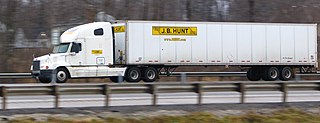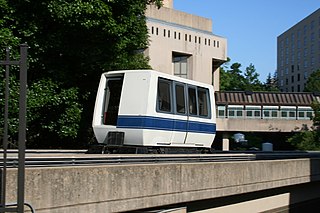
A flying car is a type of personal air vehicle or roadable aircraft that provides door-to-door transportation by both ground and air. The term "flying car" is also sometimes used to include hovercars.

An intermodal container, often called a shipping container, is a large standardized shipping container, designed and built for intermodal freight transport, meaning these containers can be used across different modes of transport – from ship to rail to truck – without unloading and reloading their cargo. Intermodal containers are primarily used to store and transport materials and products efficiently and securely in the global containerized intermodal freight transport system, but smaller numbers are in regional use as well. These containers are known under a number of names, such as simply container, cargo or freight container, ISO container, shipping, sea or ocean container, sea van or (Conex) box, container van, sea can or c can.

Intermodal freight transport involves the transportation of freight in an intermodal container or vehicle, using multiple modes of transportation, without any handling of the freight itself when changing modes. The method reduces cargo handling, and so improves security, reduces damage and loss, and allows freight to be transported faster. Reduced costs over road trucking is the key benefit for inter-continental use. This may be offset by reduced timings for road transport over shorter distances.

A sidelifter is a specialised vehicle or semi-trailer used to hoist and transport ISO standard intermodal containers over longer distances.

A Jersey barrier, Jersey wall, or Jersey bump is a modular concrete or plastic barrier employed to separate lanes of traffic. It is designed to minimize vehicle damage in cases of incidental contact while still preventing vehicle crossovers resulting in a likely head-on collision. Jersey barriers are also used to reroute traffic and protect pedestrians and workers during highway construction. They are named after the U.S. state of New Jersey which first started using the barriers as separators between lanes of a highway in the 1950s.
Hopper was a proposed European Space Agency (ESA) orbital spaceplane and reusable launch vehicle. The Hopper was a FESTIP system study design.

An autorack, also known as an auto carrier, is a specialized piece of railroad rolling stock used to transport automobiles and light trucks. Autoracks are used to transport new vehicles from factories to automotive distributors, and to transport passengers' vehicles in car shuttles and motorail services, such as Amtrak's Auto Train route.

A flatcar (US) is a piece of railroad (US) or railway (non-US) rolling stock that consists of an open, flat deck mounted on a pair of trucks (US) or bogies (UK), one at each end containing four or six wheels. Occasionally, flat cars designed to carry extra heavy or extra large loads are mounted on a pair of bogies under each end. The deck of the car can be wood or steel, and the sides of the deck can include pockets for stakes or tie-down points to secure loads. Flatcars designed for carrying machinery have sliding chain assemblies recessed in the deck.
A RoadRailer is a trailer or semi-trailer that can be hauled on roads by a tractor unit and then by way of a fifth wheel coupling, operate in a unit train on railway lines.

The Intermodal Surface Transportation Efficiency Act of 1991 is a United States federal law that posed a major change to transportation planning and policy, as the first U.S. federal legislation on the subject in the post-Interstate Highway System era.

The National Highway System (NHS) is a network of strategic highways within the United States, including the Interstate Highway System and other roads serving major airports, ports, rail or truck terminals, railway stations, pipeline terminals and other strategic transport facilities. Altogether, it constitutes the largest highway system in the world.
Truckload shipping is the movement of large amounts of homogeneous cargo, generally the amount necessary to fill an entire semi-trailer or intermodal container. A truckload carrier is a trucking company that generally contracts an entire trailer-load to a single customer. This is as opposed to a less-than truckload (LTL) company that generally mixes freight from several customers in each trailer. One advantage Full Truckload (FTL) carriers have over Less than Truckload carriers is that the freight is never handled en route, whereas an LTL shipment will typically be transported on several different trailers.

A semi-trailer is a trailer without a front axle. In the United States, the term is also used to refer to the combination of a truck and a semi-trailer, a tractor-trailer.

J.B. Hunt Transport Services, Inc. is an American transportation and logistics company based in Lowell, Arkansas. It was founded by Johnnie Bryan Hunt and Johnelle Hunt in Arkansas on August 10, 1961. By 1983, J.B. Hunt had grown into the 80th largest trucking firm in the U.S. and earned $623.47 million in revenue. At that time J.B. Hunt was operating 550 tractors, 1,049 trailers, and had roughly 1,050 employees. J.B. Hunt primarily operates large semi-trailer trucks and provides transportation services throughout the continental U.S., Canada and Mexico. The company currently employs over 24,000 and operates more than 12,000 trucks. The company's fleet consists of over 100,000 trailers and containers.

In rail transportation, a rolling highway, or rolling road is a form of combined transport involving the conveying of road trucks by rail, referred to as Ro-La trains. The concept is a form of piggyback transportation.
A specialized set of jargon describe the tools, equipment, and employment sectors used in the trucking industry in the United States. Some terms may be used within other English-speaking countries, or within the freight industry in general. For example, shore power is a term borrowed from shipping terminology, in which electrical power is transferred from shore to ship, instead of the ship relying upon idling its engines. Drawing power from land lines is more efficient than engine idling and eliminates localized air pollution. Another borrowed term is "landing gear", which refers to the legs which support the front end of a semi-trailer when it is not connected to a semi-truck. Some nicknames are obvious wordplay, such as "portable parking lot", in reference to a truck that carries automobiles.
Vermont Route 108 (VT 108) is a north–south state highway in northern Vermont, United States. Its southern terminus is at VT 100 in Stowe, and its northern terminus is at the Canada–US border in Franklin, where it continues into Quebec past the West Berkshire–Frelighsburg Border Crossing as Route 237. VT 108 is 45.450 miles (73.145 km) long.

A hovertrain is a type of high-speed train that replaces conventional steel wheels with hovercraft lift pads, and the conventional railway bed with a paved road-like surface, known as the track or guideway. The concept aims to eliminate rolling resistance and allow very high performance, while also simplifying the infrastructure needed to lay new lines.

Keith Walton Tantlinger was a mechanical engineer and inventor. As Vice President of Engineering at the Fruehauf Trailer Corporation his inventions played a major role in containerization. Working with a Fruehauf customer, Malcom McLean, they spearheaded the container ship revolution in the 1950s, Tantlinger developed much of the early technology that made modern container shipping possible while at Fruehauf. After its initial order of containers from Brown Trailer, Sea-Land switched to containers made by the Strick division of the Fruehauf Trailer Company. Fruehauf had been one of the dominant players in building truck bodies and trailers for a long time, and, as already described, had previously innovated in the design and construction of the early commercial semi-trailers. President Roy Fruehauf was impressed with the idea of containerization, so in addition to manufacturing containers for Sea-Land his company agreed to make the trailer chassis that were needed, and also to provide financing to Sea-Land for the purchase of these containers and chassis. In 1958 Tantlinger left Sea-Land and became chief engineer at Fruehauf, where he continued to work with containers. More importantly, over the years he played a key role in the process of container standardization, working extensively on a committee of the American Standards Association (ASA) and later being critically involved with the ISO's efforts. His designs included the corner casting and Twistlock systems found on every intermodal container, the spreader bar for automatic securing of containers lifted on and off ships, and the ship-shore container transfer apparatus for the first cellular container ship. In the course of his professional career, Tantlinger was granted 79 United States patents, all related to transportation equipment. Many of his patents related to commercial highway freight trailers and transit buses.

Steelbro Group is a heavy vehicle and crane manufacturer headquartered in Victoria, Australia. In 2013 it owned the Steelbro, Transtank, Fuelgear and Freightquip businesses. It grew from the company Steelbro, headquartered in Christchurch, New Zealand.














